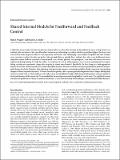| dc.description.abstract | Achild often learns to ride a bicycle in the driveway, free of unforeseen obstacles. Yet when she first rides in the street, we hope that if a car
suddenly pulls out in front of her, she will combine her innate goal of avoiding an accident with her learned knowledge of the bicycle, and
steer away or brake. In general, when we train to perform a new motor task, our learning is most robust if it updates the rules of online
error correction to reflect the rules and goals of the new task. Here we provide direct evidence that, after a new feedforward motor
adaptation, motor feedback responses to unanticipated errors become precisely task appropriate, even when such errors were never
experienced during training. To study this ability, we asked how, if at all, do online responses to occasional, unanticipated force pulses
during reaching arm movements change after adapting to altered arm dynamics? Specifically, do they change in a task-appropriate
manner? In our task, subjects learned novel velocity-dependent dynamics. However, occasional force-pulse perturbations produced unanticipated
changes in velocity. Therefore, after adaptation, task-appropriate responses to unanticipated pulses should compensate corresponding
changes in velocity-dependent dynamics.Wefound that after adaptation, pulse responses precisely compensated these changes, although they
were never trained to do so. These results provide evidence for a smart feedback controller which automatically produces responses specific to
the learned dynamics of the current task. To accomplish this, the neural processes underlying feedback control must (1) be capable of accurate
real-time state prediction for velocity via a forward model and (2) have access to recently learned changes in internal models of limb dynamics. | en_US |


